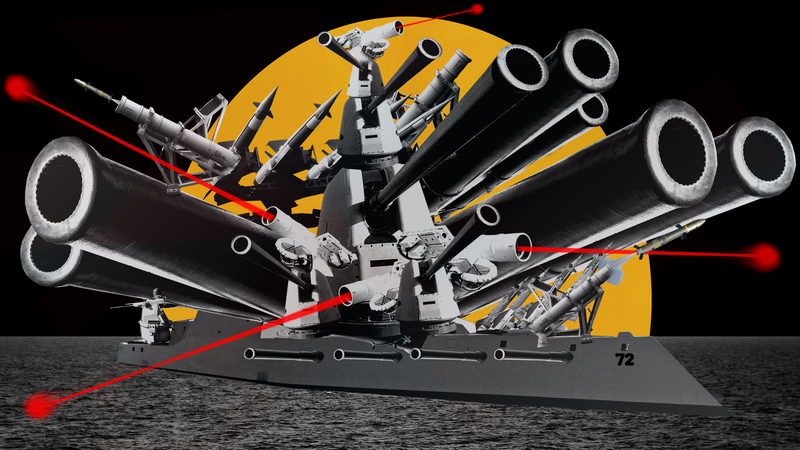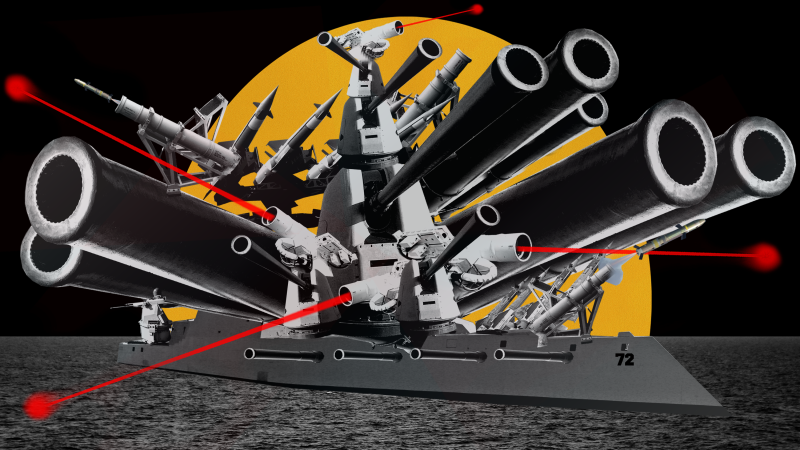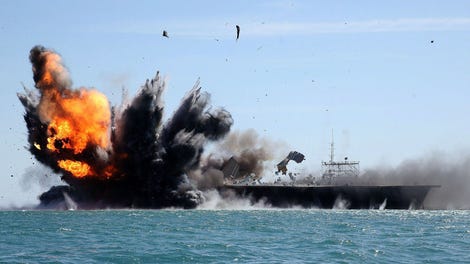
President Donald Trump seems to like big, “bold” ideas. Throw nukes around? Sure. Rip up the deck of an aircraft carrier to install the “goddamned steam?” Okay, fine. But what if we brought back one of the biggest military statements America has ever had—what if we brought back the battleship?
It’s not that the current American capital ship, the aircraft carrier, is obsolete. But thethe Gerald R. Ford-class of aircraft carriers are remarkably, enormously expensive, and potentially vulnerable to many kinds of attack. Many of the Navy’s other surface ships exist essentially in order to support and defend the carrier, making a carrier battle group a huge investment of national treasure.
Advertisement
What if another kind of ship could take on some of that load?
The U.S. stopped building battleships in the 1940s. Aircraft, submarines, and missiles, able to strike more securely and at greater distance than the guns of a battleship, rendered the type obsolete. Nevertheless, over the years various analysts have proposed a new, large surface combatant that would play some of the same roles as a classic battleship.
Let’s imagine what such a ship might look like; what it needs to do, how it would fight, and how much it might cost.
What It Would Need To Do
We’ll call our notional battleship the USS Montana (BBGN-72). Besides Hawaii, Montana is the only of the 50 U.S. states never to have successfully bestowed its name upon a battleship, and the current USS Hawaii is a Virginia-class nuclear attack submarine. Also, the last class of American battleships that ever made it to the drawing board was going to be named after a USS Montana.
But our new USS Montana will displace somewhere north of 30,000 tons, at least twice the size of the very latest and greatest American destroyer, with a 30-knot speed similar to that of existing US cruisers, destroyers, and aircraft carriers.
A battleship must have the capability to kill other ships. If it can’t do this, then it isn’t a battleship; it’s a monitor, or “arsenal ship.” This means that any modern battleship needs an array of sensors necessary to detect enemy ships, as well as guns and missiles capable of sinking them. Until fairly recently, the U.S. Navy leaned away from using surface ships in an anti-ship role, preferring aircraft and submarines. With the advent of “distributed lethality,” or the idea of networking everything that flies or floats into a giant kill-chain however, surface vessels have gotten back into the job of ship-killing.
Advertisement
Sponsored
Attacks against land were also historically an important, if secondary, role for a battleship. Even before the end of World War II, however, battleships more often found themselves hitting land targets than pounding one another. After the war, land attack became paramount, and the Iowa class battleships acted primarily as land attack platforms, hitting the enemy not only with guns, but also with long-range missiles.
Given the complexity of fighting a modern anti-access/area denial system, USS Montana requires a substantial land attack capability, manifested in guns and missiles.
And finally, a battleship needs to defend itself. From ironclad to dreadnought, battleships carried heavy armor to defend themselves against the heavy shells of enemy battleships, and eventually to protect themselves against torpedoes and bombs. Secondary guns countered the threat of torpedo boats and small destroyers.
Advertisement
After the invention of the airplane, battleships carried increasingly heavy anti-aircraft armaments, in order to protect both themselves and any accompanying ships. Consequently, a battleship cannot rely on other ships to protect it; it must be able to defeat incoming threats in some fashion in order to deserve the name. Our USS Montana needs anti-aircraft, anti-missile, and anti-submarine defenses.
What It Would Need To Carry
Guns
Classic battleships were evaluated primarily by the size of their guns. The earliest dreadnoughts carried 305mm guns, while the final specimens of the type carried 406mm or 446mm weapons. Battleships needed these guns to punch through the armor of enemy battleships, and wreak destruction on the vulnerable innards of their counterparts. This is no longer a priority in naval architecture; everyone expects ship-to-ship combat to happen at ranges longer than heavy guns can reach.
The Arleigh Burke-class destroyer carries a 127mm gun for shore bombardment and anti-surface purposes. The gun has a range of 24km, but doesn’t seem to pack enough punch for a battleship. The Advanced Gun System of the Zumwalt-class destroyer comes much closer to what we would want in a battleship. A 155mm gun, the AGM can launch a projectile capable of accurately hitting targets nearly seventy miles away. The Navy has cancelled procurement of the projectile because it’s too expensive, but for the purposes of this exercise we can assume at least two AGMs, which can each fire ten shells per minutes.
Advertisement
Advertisement
The next step is a rail gun. A rail gun uses electro-magnetic force to launch a solid projectile at extremely high speed and with great destructive force. The Navy would like a railgun to deliver projectiles at up to 200 miles from the launcher, with a circular error probability of five meters. Like the AGM, the rail gun could fire 6-10 times per minute, and unlike the AGM the projectiles would be inexpensive and easy to store. Considerable technical challenges remain, but a ship the size of USS Montana, with high energy production capacity, is a great bet to act as a platform for at least one rail gun.
In the end, the USS Montana would have two railguns, capable of launching tungsten rods at targets 200 miles away, with the ability to wreak utter destruction based on kinetic energy alone.
Missiles
Any vision of a future battleship includes a great number of missiles. Most large modern surface warships include vertical launch systems, which allow them to carry a variety of missiles for a bunch of different contingencies. The 512 VLS cells proposed for the arsenal ship are a good starting assumption; they would give our battleship long-range hitting power that could far exceed the Kirovs or the Iowas, while also providing an effective air defense and ballistic missile defense battery.
The VLS system is extremely flexible; our battleships could carry different missile loadouts depending on the threat environment. Action in a permissive environment (blasting a small country that can’t shoot back) would require a heavy emphasis on land-attack missiles. In a less permissive environment, the battleship would load up on anti-aircraft missiles in order to defeat incoming threats. In a classic fleet engagement, a mixed load of SAMs and anti-ship missiles would make BBGN-72 a formidable opponent.
The specific kinds of missiles will vary over the lifetime of the battleship. Right now, Tomahawks for land and naval attack, Evolved Sea Sparrows (four of which can fit in each VLS cell) for close air defense, and Standard missiles for naval attack, long range air defense, and ballistic missile defense would fill the VLS cells, depending on the nature of the mission. And the great thing about the VLS system is that as the missiles improve (through the introduction of the Long Range Stand Off (LRSO) missile, for example), the killing potential of the ship also improves.
Advertisement
Advertisement
USS Montana could carry an arsenal in excess of five “normal” Arleigh Burke-class destroyers. With the proper sensors, Montana could defend herself with only a minimal escort, probably pairing with a nuclear attack submarine to provide a formidable offensive or defensive unit.
Drones
Like all modern surface ships, USS Montana would require facilities for helicopters to handle search, transportation, and anti-submarine duties. Increasingly, however, the U.S. Navy has looked into using surface ships as platforms for the deployment of air, surface, and sub-surface drones. With her great size, Montana could act as a mothership for a variety of unmanned vehicles, employing them either as sensors or, in time, as weapons in their own right. With a hanger only somewhat larger than that of the Arleigh Burke Flight II destroyers, she could carry a combination of helicopters (up to three) and UAVs.
Lasers
A laser serves primarily as a defensive weapon, targeting incoming cruise and ballistic missiles before they can strike the ship. The laser heats the incoming missile until it cracks or melts, leading to a premature detonation. The laser avoids many of the problems associated with hitting a bullet with a bullet, and eliminates the need for devoting magazine space to defensive weapons. The laser can also target the drones and other reconnaissance vehicles that make up the enemy “kill chain;” the system of systems necessary to effectively target a ship. The Navy is on the cusp of testing a 150kw laser; it has already successfully incorporated a smaller laser on USS Ponce (LPD-15), although it remains experimental.
Nuclear Power
The economic logic for nuclear-powered warships has foundered on persistent low oil prices. The new case for nuclear power focuses on the energy-hunger of modern weapon and sensor systems. In particular, the rail gun and laser systems would benefit enormously from high wattage reactors.
Advertisement
The A1B nuclear reactors carried by the USS Ford class each generate 300MW of electricity, well in excess of what the ships currently require. Depending on the size of the hull, USS Montana could conceivably carry two reactors, providing for a high speed in addition to the power needed for sophisticated weapon systems.
Armor
Naval architects effectively gave up on armor in late October 1944, when swarms of American carrier aircraft sank HIJMS Musashi, the largest and most heavily armored battleship ever constructed. After World War II, the focus shifted to prevention, with ships attempting to defeat incoming aircraft and missiles with their own missiles, or with close-in guns. Although this approach has saved a lot of dead weight, it has its own limitations; in the Falklands War the Royal Navy lost ships from missile strikes even when the warhead failed to explode.
Since the 1970s, modern warships have moved slightly in the other direction, adding lightweight Kevlar armor to protect the most critical areas of the ship from gunfire and other kinds of explosions. Similarly, most designers have moved away from aluminum superstructures in favor of steel, which offers greater protection from small arms and small caliber guns. Against large missiles or heavy artillery, modern ships remain extremely vulnerable. That said, a ship the size of Montana could easily incorporate a light armored sheath (perhaps half an inch) to protect its most critical spaces, and to mitigate the damage inflicted by missiles and other lethal weapons.
Advertisement
Advertisement
But a return to the heavily armored battleship seems unlikely. Heavy armor can protect hulls and gun turrets, but superstructures were always vulnerable to shellfire. As the fighting power of a ship increasingly rests on its sensor and electronic systems, heavy protection for the hull offers limited returns for the weight added. A World War II battleship could continue fighting even after its upper works were ravaged by guns; a modern warship can’t.
Sensors
Sensor technology evolves rapidly, but we can say that USS Montana would need a full suite of air and subsurface sensors in order to adequately perform its multirole duties. The Air and Missile Defense Radar (AMDR, or AN/SPY-6), scheduled for fitting on the Flight III Arleigh Burke destroyers, would allow Montana to engage hundreds of targets simultaneously. The AMDR can detect targets half-the-size of older radars, at twice the range. Best of all, the AN/SPY-6 is scalable, meaning that Montana could employ a more powerful radar system than even the Flight III Arleigh Burkes. Montana would also require a sonar suite similar to that of the latest Burkes.
We can also envision a ship the size of USS Montana playing a cruiser role, managing the air defense of an entire battlegroup. This would involve integrating information received from a host of different sensors. Indeed, USS Montana might be the ideal platform for managing the Navy’s “distributed lethality” concept.
What It Would Cost
Estimates on the cost of naval vessels is, at best, guesswork. Like every project, ships face cost overruns; the Littoral Combat Ship, the Zumwalt-class destroyer, and the Ford-class aircraft carrier have all seen serious cost increases. Some classes manage to escape this, but in most cases this happens because the ships fit into a manageable template, with a clear lineage from previous designs and a suite of proven technologies. The Virginia-class submarines and the America-class LHAs fit into this mold; USS Montana most certainly would not.
Best to start with what we already know. Cost estimates for the cheapest version of the arsenal ship (without much in the way of defensive armament) ran between $500-$800 million per vessel. The since-cancelled CGX cruiser program estimates ran upward of $3 billion per unit, although much would have depended on how much technology the ship could have shared with the Zumwalt-class. But the Zumwalts themselves ended up at $4 billion a pop, not including research and development costs. The U.S. hasn’t built more than four battleships to a class since the Connecticut-class from over a hundred years ago, and given both the pace of technological change and the uncertainty associated with the concept, it’s unlikely that Montana would lead a group of more than four ships.
Advertisement
Advertisement
Consequently, we’re probably looking at something between the Zumwalt-class and the Ford-class carrier ($10 billion) in costs. Split the difference and toss in another $10 billion in research and development (a touch more than the Zumwalts, although this might come down as the Montanas can take advantage of some of the Zumwalt’s technologies, and probably won’t use a tumblehome hull), and we have a program that will yield four battleships for around $38 billion.
On the upside, we won’t need to accessorize USS Montana with several squadrons of F-35s. A carrier air group costs upwards of $6 billion, and requires replacement more than once over the course of a carrier’s career. The USS Gerald R. Ford also requires a crew of over 4000, probably ten times what Montana would need. This means that Montana would have a big advantage over Ford in terms of life cycle and operating costs, although it’s hard to say exactly how big that advantage might be.
The Pros
Everybody likes big boats; we cannot lie. And the Russians have undoubtedly put its massive Pyotr Velikiy battlecruiser to good propaganda use over the past decade. Given the expansion of the Chinese surface fleet, it sure would be nice to have some units capable of engaging both the surface ships of the PLAN, and the anti-access/area denial system that is slowly extending into the South China Sea. In short, there is a strategic rationale for a modern battleship.
Advertisement
Perhaps more important, the technology has begun to shift in the direction of large surface combatants. Big ships can carry more VLS cells; they have more space for drones and guns; and they have the power generation capacity necessary to effectively employ lasers, railguns, and advanced sensor equipment. After seventy years in which it made little sense to build a surface combatant bigger than 10000 tons, there is once again a technological justification for big ships. We are already seeing the first steps toward this trend in the designs of the arsenal ship and the CGX, and in the construction of such large destroyers as the Zumwalts, the South Korean Sejong the Greats, and the Chinese Type 055s.
The Cons
These ships will be large and expensive. Many of the technologies have not reached maturity, and delays and failures will inevitably drive up costs. They will not be invulnerable; most of the arguments against aircraft carriers will also apply to Montana and her sisters.
Is It Even Worth A Genuine Look?
USS Montana (BBG-72) is worth a more detailed look. The U.S. Navy has found space for large surface combatants in its plans since the 1980s, even if it has generally failed to pull the trigger. A class of large, multi-role ships intended for combat operations in contested seaspace could do some of the jobs now reserved for carriers and submarines, and could affect Chinese and Russian thinking about how to construct an anti-access/area denial bubble. These battleships could also serve as test beds for the integration of high end technologies that are only now beginning to mature.
Advertisement
Advertisement
But “a detailed look” does not mean “we should build them now.” The limited U.S. Navy shipbuilding budget is already struggling with key priorities such as the development of a new frigate, and the continuing growth of carrier costs. If the U.S. Navy wants to reach 350 ships quickly, battleships may be part of the answer, but they won’t be the first part of the answer.
To put it differently: Does the extant strategic and technological environment support the development of a multirole surface combatant considerable larger than existing U.S. Navy cruisers and destroyers?
The answer is yes; offensive and defensive weaponry have evolved such that size once again offers significant potential benefits, and in the People’s Army Liberation Navy the U.S. Navy now faces its most significant long-run challenge since the Cold War, and possibly since World War II. Can, given other priorities, the United States undertake the construct of a new large surface combatant? Maybe; it depends on the commitment that the US government wants to make to the U.S. Navy.
What Has Gone Before
The appeal of the battleship has held on for longer than the battleship itself. Most of the survivors of World War II were scrapped shortly after the conflict; a few held on in the U.S., the U.K., and France, but by 1968 the only stragglers were museum ships and the four Iowa-class battleships that the U.S. used in World War II and the Korean War. But that doesn’t mean the dream of a big surface combatant ever faltered.
The Soviet Kirovs are the largest surface combatants built in the last seventy years. Displacing 24,000 tons, they check many of the main boxes on what a modern battleship should look like. Pyotr Velikiy, the only remainingKirov-class battlecruiser in service (Admiral Nakhimov, her sister, has been in Russian modernization purgatory since 1999, but might eventually return to service, someday, maybe, who knows), carries 2 P-700 “Shipwreck” anti-ship missiles, an S-300 surface-to-air missile system, an array of anti-submarine weapons, and a variety of sensors designed to detect targets. Powered by a combination of nuclear reactors and conventional steam turbines, Pyotr Velikiy can make 32 knots. However, the Kirovs lack any significant land attack capability beyond a twin 130mm gun.
Advertisement
From the 1950s on, the U.S. Navy looked at a bewildering array of proposals for modernizing the Iowa-class battleships. Most of these involved ditching some portion of the main armament in favor of missiles or an expanded flight deck. Given the scarcity of enemy battleships that needed holes punched in them after World War II, it made little sense to keep all three 16” turrets. Plans for radical renovation of the Iowas inevitably ran aground on the shoals of fiscal necessity, however. When the construction of the Kirovs finally kick-started the modernization of the Iowas in the 1980s, the modifications were fairly minimal; the addition of anti-ship and land attack missiles, and the removal of a few five-inch guns. This produced a formidable land-attack platform, but not a ship that was particularly threatening to enemy vessels, or that was able to defend itself beyond its heavy armor.
But the idea for a huge arsenal ship remained all the rage in the 1990s, when it seemed that the United States could solve even the thorniest of problems with a volley of cruise missiles. Equipped with a 512-cell Vertical Launch System, the arsenal ship would have deployed off the coast of a prospective target, then saturated the unfortunate victim with wave after wave of Tomahawks. The largest version of the proposed ship would have displaced around 30,000 tons, and included some self-defense systems. The arsenal ship died, however, when it became apparent that the U.S. Navy would be able to convert some Ohio-class SSBNs into cruise missile trucks at a lower cost, and with greater survivability.
Advertisement
The Navy took a different tack with the CGX. Forseeing a need to replace the Ticonderoga-class cruisers in the not-too-distant future, the Navy envisioned a ship that would displace around 25,000 tons, equipped with many of the features that eventually ended up in the Zumwalt class destroyer. Compared with the Zumwalt, the CGX would have had enhanced air defense systems, ballistic missile defense capability, and a nuclear propulsion system to generate all of the necessary power. But in the end, the Navy couldn’t force Congress to cough up enough money to buy an adequate number of Zumwalts, much less the CGX.
Rob Farley teaches national security and defense courses at the Patterson School of Diplomacy and International Commerce at the University of Kentucky. He is the author of Grounded: The Case for Abolishing the United States Air Force, and he literally wrote the Battleship Book. Find him on twitter @drfarls.
















